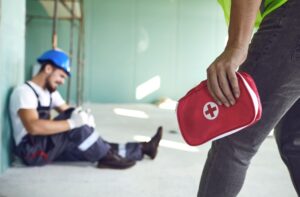In our day-to-day operations, ensuring the safety of our workplace is not just a duty but a necessity that protects us all. Understanding the concept of health and safety risk assessments is fundamental in this process. These assessments help us identify potential risks in our work environment and determine the best ways to mitigate them. By doing so, we’re not only complying with legal requirements but genuinely looking after the well-being of every team member.
Risk assessments are like the map in a treasure hunt; they guide us to spots where hazards might exist and help us put measures in place to avoid potential accidents. However, it’s vital that these assessments are carried out correctly. They need to be thorough, focusing on real risks and practical measures, rather than just ticking boxes to say the job is done.
In the following sections, we’ll explore what a health and safety risk assessment really involves, uncover its critical elements, discuss common mistakes to avoid, and illustrate how regular assessments can dramatically improve workplace safety. This way, we ensure that our company not only remains a safe place to work but also a model of how risk management should be handled effectively.
What Is a Health and Safety Risk Assessment?
A health and safety risk assessment is a careful examination of what in our workplace could cause harm to people. This allows us to weigh whether we have taken enough precautions or should do more to prevent harm. The goal is to ensure nobody gets hurt or becomes ill due to the work they do. By identifying and analyzing potential hazards, we make our workplace safer for everyone, from employees to visitors.
Conducting these assessments involves looking at the tasks, processes, and the environment of our workplace to determine where risks may arise. Once identified, we determine the likelihood of these risks causing harm and decide on appropriate measures to eliminate or manage them effectively. This proactive approach is crucial because it helps prevent accidents before they occur, creating a safer and more compliant workplace.
Key Elements of Effective Risk Assessments
To conduct an effective risk assessment, certain key elements must be in place. First, it’s vital to have a clear understanding of all aspects of the work being assessed. We need to consider who might be at risk, including employees, visitors, and even contractors. Each group might face different risks, so it’s important to consider everyone.
- Identification of Hazards: Walk around the workplace and look at what could reasonably cause harm. We ask opinions from our team as they might notice things not immediately obvious.
- Deciding Who Might Be Harmed and How: For each hazard, we need to be clear about who might be harmed; this helps us identify the best way to manage the risk.
- Evaluating Risks and Deciding on Precautions: Here, we assess the severity and likelihood of the harm a hazard could cause and decide on measures to effectively prevent it. This could involve changing how we work, providing protective equipment, or offering training on new safety measures.
With these elements, our risk assessments become a powerful tool in our health and safety strategy, ensuring that we manage risks effectively and keep our workplace safe. Each step is crucial for ensuring comprehensive coverage of all potential hazards and their mitigation strategies.
Common Pitfalls in Conducting Risk Assessments
One of the major stumbling blocks in conducting effective risk assessments is the lack of understanding about what exactly poses a risk. Often, we might overlook or underestimate potential hazards because they don’t seem immediately dangerous or because they’ve never caused issues before. This complacency can lead to serious accidents. Another common pitfall is not involving our team in the risk assessment process. The individuals who perform the tasks daily have invaluable insights into the potential risks and effective ways to mitigate them.
Furthermore, once risks are identified, failing to implement adequate control measures, or not following through with the measures established, can render the assessment ineffective. Regularly updating the risk assessment is also crucial, as work environments and processes evolve. If we stick rigidly to an outdated assessment without accommodating new changes or potential risks introduced by new equipment or procedures, we are effectively setting ourselves up for failure.
Improving Workplace Safety Through Regular Assessments
Regular risk assessments are key to maintaining and improving safety standards within the workplace. By conducting these assessments frequently, we ensure that new risks are identified promptly and that the safety measures remain relevant and effective. This proactive approach helps us to continuously evolve and update our working methods, equipment, and training to address the dynamic nature of our work environments.
Each assessment serves as an opportunity to refine our procedures, making them safer and more efficient. We also reinforce the culture of safety that values vigilance, proactivity, and mutual responsibility. Promoting an ongoing dialogue about safety and providing continuous training supports these goals, ensuring that everyone is equipped with the knowledge to work safely and efficiently.
Final Thoughts
At CR Training Solutions, we believe that a strong commitment to regular and comprehensive health and safety risk assessments is essential for maintaining a safe working environment. Our approach is not just about meeting regulatory requirements; it’s about actively fostering a culture of safety and well-being throughout the organization. We are dedicated to supporting businesses in achieving these goals through our expert consultancy and training services.
If you’re looking to elevate your company’s safety standards, we invite you to get in touch with us at CR Training Solutions. Let our health and safety consultants help you integrate a robust safety process that protects your most valuable assets—your people. Together, we can ensure that your workplace is not only compliant but also a safe, healthy, and productive place for everyone.




